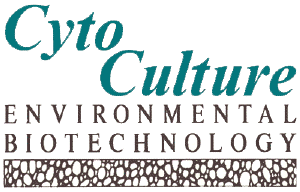
| In house field application
and monitoring assays
Ammonia Nitrogen The assay measures the concentration of bio-available nitrogen as ammonia in parts per million (ppm) for a given water or soil sample. Nitrogen is essential for the growth of bacteria in situ (protein synthesis, nucleic acids, membranes) and is most readily assimilated in the form of dissolved ammonia. The assay utilizes pre-calibrated reagents and a spectrophotometer for the colorimetric measurement (Nesslerization method, without preliminary distillation step) of dissolved (water) or extracted (soil) ammonia as modified from Standard Methods for the Examination of Water & Wastewater, method 4500-NH3 C (18th Ed., APHA, AWWA, WEF, 1992). The reporting limit for the assay is 0.1 mg/L (water) or 0.1 mg/g (soil) as ammonia (NH3) nitrogen. Ortho-Phosphate The assay measures the concentration of bio-available phosphorus in ppm as ortho-phosphate for a given water or soil sample. Ortho-phosphate can serve as an excellent source of phosphorus required for the growth of hydrocarbon-degrading bacteria in soil and ground water (phospholipids, protein and nucleic acids). Phosphate is often rate limiting for in situ biodegradation as it is readily adsorbed to clay soils or precipitated by Ca++ and Mg++. The phosphate assay utilizes pre-calibrated reagents and a spectrophotometer for the colorimetric measurement of dissolved (water) or extracted (soil) ortho-phosphate modified from Standard Methods for the examination of Water & Wastewater, method 4500-P E (18th Ed., APHA, AWWA, WEF, 1992). The reporting limit for the assay is 0.1 mg/L (water) or 0.1 mg/g (soil) of phosphorus as ortho-phosphate (PO4=). Nitrate Nitrogen The assay measures the concentration of bio-available nitrogen in ppm as nitrate for a given water or soil sample. Nitrate can serve as both a nitrogen source for hydrocarbon-degrading bacteria as well as a terminal electron acceptor for facultative bacteria growing in low oxygen environments (nitrate respiration). The assay utilizes pre-calibrated reagents and a spectrophotometer for the colorimetric measurement of dissolved (water) or extracted (soil) nitrate by the cadmium reduction method modified (with EDTA, without organic pre-extraction) from Standard Methods for the Examination of Water & Wastewater, method 4500-NO3- E (18th Ed., APHA, AWWA, WEF, 1992). The reporting limit for the assay is 0.1 mg/L (water) or 0.1 mg/g (soil) of nitrogen as nitrate (NO3-). Sulfate The assay measures the concentration of sulfate in ppm as sulfur for a given water or soil sample. Like nitrate, the oxygen-bearing sulfate can serve as a terminal electron acceptor in the absence of molecular oxygen. However, sulfate utilization by sulfate reducing bacteria results in the formation of corrosive and toxic hydrogen sulfide (H2S). The sulfate assay utilizes pre-calibrated reagents and a spectrophotometer for the measurement of dissolved (water) or extracted (soil) sulfate by USEPA method 375.4 (HACH SulfaVer turbidimetric/ colorimetric method 8051). The reporting limit for the assay is 0.1 mg/L (water) or 0.1 mg/g (soil) of sulfate (SO4=). pH Values for pH of water samples, or water extracts of soil samples, are measured with a HACH digital pH/mV meter equipped with a glass electrode. The pH measurement is reported as the average of three readings for each sample after calibration with reference buffers as described for the electrometric method in Standard Methods for the Examination of Water & Wastewater 4500-H+ B (18th Ed., APHA, AWWA, WEF, 1992). Dissolved Oxygen (D.O.) Dissolved oxygen is measured by the membrane electrode method (SMWW 4500-O G) in a stirred water sample using a Yellow Springs Instruments polarographic oxygen meter (model 54A. D.O. is reported as the average of three readings after calibration of the instrument with aerated water at ambient temperature. Oxidation Reduction Potential (ORP) Oxidation reduction potential is measured using method SMWW 2580B using a Corning combination redox electrode and a HACH digital pH/mV meter. |
||||||||||||||||
| Assays for large-scale
investigations requiring state-certified analyses are subcontracted to:
Curtis & Tompkins, Ltd., Berkeley CA K-Prime Laboratory, Santa Rosa, CA Zymax Envirotechnology, San Luis Obispo, CA Call or email CytoCulture for quotes on the following geochemical and biodegradation monitoring parameters recommended by the AFCEE, USEPA and USGS monitored natural attenuation protocols:
|
For more information about CytoCulture and services,
please CONTACT US .